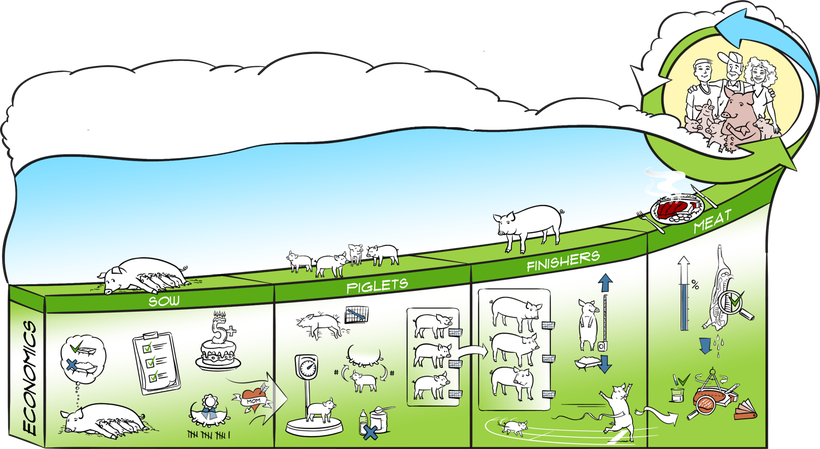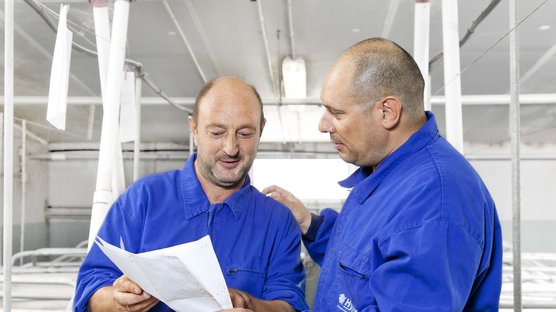
Published on March 31, 2021
New perspective on economic swine performance
Economic sustainability of the swine sector has two factors. One is the success of the sector over time, and the other is the way the swine sector operates in a sustainable manner, protecting social and environmental elements. Sustainability considers not just today’s economic performance, but the economic performance in tomorrow’s reality too. As a sector, we need to be more efficient in our use of available resources, find new ways to utilize currently underused resources, and incorporate new resources in swine production.
For sustained economic swine production, environmental, social and economic pathways all interact. Greenhouse gas emissions and land use are themes in the environmental pathway, and animal health and welfare are themes in the social pathway. Ideally, sustainability initiatives address a range of themes covering all three sustainability pathways. An innovation that focuses on improving one could have adverse and unexpected consequences for other sustainability pathways. This may decrease the overall sustainable performance of the system. Consideration of the three sustainability pathways is needed to breed swine solutions that are economically viable, environmentally sound, and acceptable from a social perspective. Hendrix Genetics wants to pave the way towards a more economically sustainable pork industry. As a global leader in swine breeding, with our brand Hypor, we want to set the standards in sustainable swine breeding.
In this article we will focus on the economic sustainability of the swine sector, where obvious indicators are revenues, cost, and profitability. We will cover these indicators by focusing on:
- Enhancing efficiency,
- Improving productivity, and
- Preventing waste.
Enhancing efficiency
Genetic progress is primarily focused on enhancing efficiency step-by-step to create economic returns for the pork chain. The efficiency of how sows, piglets and finishers produce pork lies at the foundation of our Hypor breeding program. To start with, we are constantly improving the feed efficiency of the sow, which is most often a forgotten area where there are differences between different dam line genetics.
Next to a feed efficient sow, labor efficiency is important. Farm labor is increasingly scarce, and therefore calm behavior, easy management, weaning capacity, and the length of a sow’s reproductive life, are all import factors that weigh heavily on farm labor. Why waste labor on tasks that a self-reliant sow can perform herself?
Our sustainable standard for number of functional teats: 4 x 4 = 16
The number of teats and the position are important. We are working towards 16 teats in total: 4 sets above the navel and 4 sets below the navel. With the overall goal that the number of functional teats is the same as the number of total born piglets to prevent the need for nurse sows.
An additional aspect of enhancing the efficiency of the sow is ensuring she is equipped with the right qualities, such as having enough teats; in our breeding herds we have almost reached the average of 16. This number is important to reduce the competition for teats among the piglets by providing a functional teat for every piglet and preventing the need for nurse sows. They also need to provide their offspring with quality colostrum and milk.

Improving productivity
Productivity is normally defined as the ratio between the output of production and the input of production factors. Output is not merely measured by the numbers, but equally important by the quality of the output. Quality is important right from the start. Therefore, we do put selection pressure on piglet birth weight in all our product lines. Today, we reach an average of 1.5 kg/3.3 lbs. in our commercial piglets, which will deliver more profit due to higher survivability, growth, and more full value finishers. Next to birth weight, we have put more pressure on selection for lower variation in birth weight within a litter. Uniformity pays off throughout the entire phase from birth to finish, enabling more turns per year and more pigs hitting the grid.
Our standard for sustainable piglet birth weight: 1.5 kg/3.3 lbs.
Piglet birth weight is proven to influence lifetime performance, with heavier birth weight piglets being more likely to survive and reach market in fewer days. We strive to have no piglets <1 kg/2.2 lbs. at birth.
Preventing waste
Perhaps the most obvious source of economic returns is the prevention of waste. Going back to the sow, we want to prevent the use of good sows for nursing piglets they didn’t farrow themselves. Clearly this is a hidden cost that has an enormous impact on the overall economic sustainability of an individual swine producer and the sector in total. Preventing the birth of low weight piglets through genetic selection helps to lower waste of feed, labor and antibiotics as research has indicated that small piglets are far less efficient with these resources. This is an aspect where we have a clear advantage over competition. Strongly correlated to birth weight is survival in the pre-weaning, nursery and finishing phases. Losing animals in the process is a waste we want to avoid at all times, and depending on when they die, has differing economic consequences. Therefore, we have set our standard for full value finishers at 95%.
Standard: 95%, Full value finishers
Any pig that reaches or survives to the market and/or slaughterhouse requirements at the specified target weight (depending on the region). This means 95% of pigs placed in the nursery must reach the market, and we steer towards 2% nursery mortality and 3% finishing mortality.
Finally, after all the energy and resources invested in raising pigs, we should consider the end product. The economic return on a carcass can be impacted by yield, drip loss, the level of muscle depth, fat depth, and meat quantity and quality depending on the region. The more carcasses that hit the grid of the market or slaughterhouse, the more economic value is created. We strive for 98% of the full value finishers that reach the market, to hit the grid. The grids will vary around the world, but our sire lines are well suited for many markets, with carcass characteristics that fit grids well.
Standard: 98% Hitting the grid
Of the full value finishers that reach the market, we strive for 98% of these pigs to hit the grid. It is dependent on the market whether these grids use a live or carcass weight, muscle or fat depth, lean yield, or primal yield targets.
Economic sustainability is important for continued success of the swine sector and provides a solid foundation for increased investment in other vital social and environmental pathways of sustainability. Setting the standard for sustainable swine breeding is our contribution to Better Breeding Today for a Brighter Life Tomorrow.



